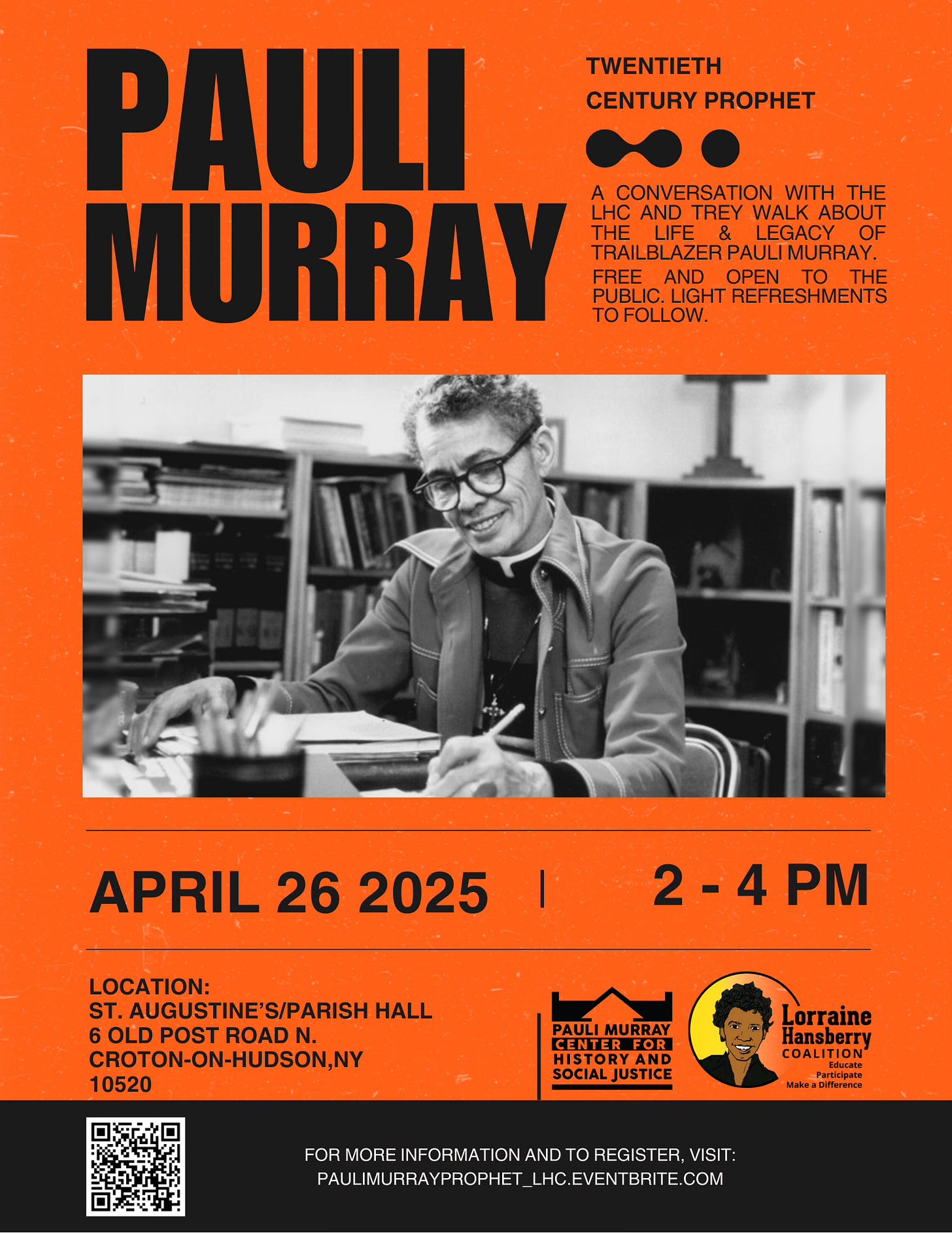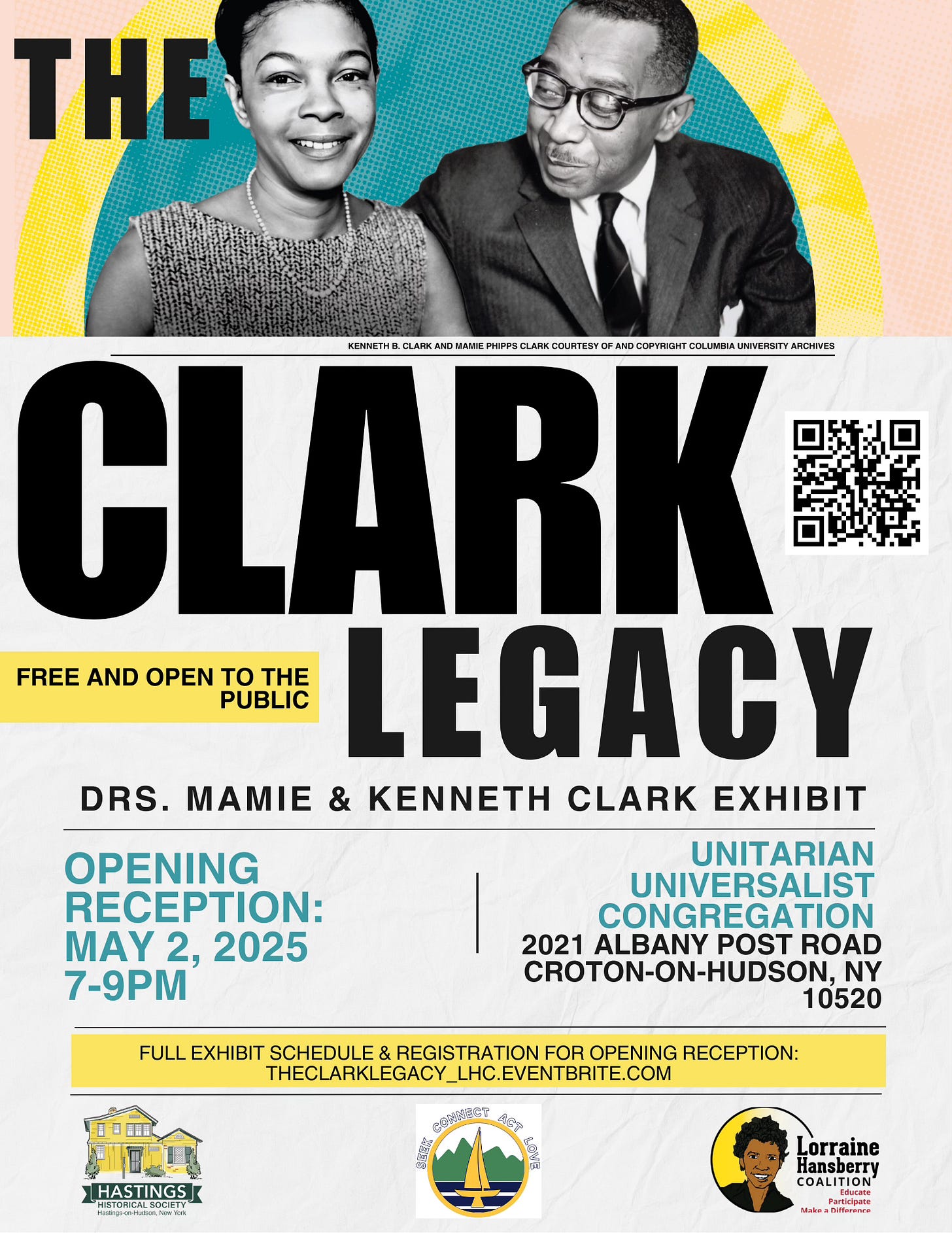Guest Editorial: Lost Causes Found -- Drs. Mamie and Kenneth Clark, Pauli Murray, and Lorraine Hansberry.
"While the list of their individual accomplishments is both exhaustive and impressive, it’s the moments when their collective work overlapped that make their public triumphs particularly compelling."
by Signe Bergstrom, Lorraine Hansberry Coalition
Drs. Mamie and Kenneth Clark, Pauli Murray, and Lorraine Hansberry were no slouches. Trailblazers in their respective fields, their professional lives were comprised of many “firsts”: the husband-and-wife powerhouse duo Drs. Mamie and Kenneth Clark were the first Black students to get doctoral degrees in psychology from Columbia University; Kenneth was the first full-tenured Black professor at the City College of New York and the first Black president of the American Psychological Association; Pauli Murray was the first Black person to earn a Doctor of the Science of Law degree from Yale Law School and the first Black woman to be ordained an Episcopal priest; Lorraine Hansberry was the first Black woman to debut a play on Broadway.
While the list of their individual accomplishments is both exhaustive and impressive, it’s the moments when their collective work overlapped that make their public triumphs particularly compelling.
When the Clarks were conducting their seminal research on the impacts of segregation in the 1940s, Murray was busy organizing sit-ins and letter-writing campaigns to protest Jim Crow and Jane Crow. Her letters gained the attention of no less than First Lady Eleanor Roosevelt, with whom she’d have a life-long friendship. Hansberry was still a young girl in 1940 when her father, Carl, was the plaintiff in the Supreme Court decision Hansberry v. Lee, a case he not only won, but one that would also inform his daughter’s seminal play A Raisin in the Sun years later.
In 1954, research from the Clarks’ studies—along with a novel legal argument Murray presented in her thesis statement at Howard University years earlier—was used as part of the successful legal framework for Brown v. Board of Education. Murray wasn’t credited for her contribution, although Thurgood Marshall did do her the favor of later describing her six hundred-plus page book State’s Law on Race and Color as “the bible” of civil rights litigation. Ruth Bader Ginsburg would cite Murray in the 1996 landmark case, United States v. Virginia.
Like most trailblazers, Murray was ahead of her time and usually worked behind the scenes. In speaking about her struggles, she wrote, “In not a single one of these little campaigns was I victorious. In other words, in each case, I personally failed, but I have lived to see the thesis upon which I was operating vindicated. And what I very often say is that I’ve lived to see my lost causes found.”
Murray was assuming a position as a senior lecturer at the Ghana School of Law in Accra when A Raisin in the Sun debuted on Broadway. At around the same time in North Carolina, a group of students staged a sit-in at a Woolworth’s lunch counter that would spark a flurry of other acts of civil disobedience and turbo-charge the civil rights movement of the 1960s. A year later, President John F. Kennedy appointed Murray to the President’s Commission on the Status of Women Committee (PCSW). And, on a hot summer day in 1963, Hansberry and Dr. Kenneth Clark, along with several other luminaries of the day, including James Baldwin, Lena Horne, and Rip Torn, among others, would confront President Kennedy’s brother, Attorney General Robert Kennedy, at the Kennedy’s family home in New York City about the administration’s lack of support for the civil rights movement.
Mere months later, Hansberry would host the Rally to Support the Southern Freedom Movement at Croton-on-Hudson’s very own Temple Israel.
On their own, the Clarks, Murray, and Hansberry are towering figures, but taken together, they’re a sum greater than their individual parts; their work inspired countless others, the reverberations of which we’re still feeling—and debating—even today. Why is it, then, that so few people have heard about Pauli Murray or know that Lorraine Hansberry lived in Croton and is buried here or that the Clarks were our Westchester neighbors?
This Spring, the Lorraine Hansberry Coalition (LHC) of Croton is hosting two unique events to shine a light on the life and times of Hansberry’s trailblazing contemporaries, Pauli Murray and Drs. Mamie and Kenneth Clark:
Join us from 2-4 PM on April 25, 2025, at St. Augustine’s Church for Pauli Murray: Twentieth Century Prophet as we discuss Murray’s impact on generations of legal precedent, human rights advocacy, and cultural thought with human rights advocate Trey Walk of the Pauli Murray Center. Register for tickets here.
And in May, the LHC brings The Clark Legacy exhibit to Croton’s Unitarian Universalist Congregation (UUC). Originally created and curated by the Hastings Historical Society, this exhibit gives a behind-the-scenes look at the Clarks, covering everything from their personal lives and marriage to a history of Hasting’s integrated neighborhood of Pinecrest to the background stories of some of the Black luminaries who were their friends, including Minnijean Brown-Trickey of the Little Rock Nine, who lived with them in the late 1950s. For more information, exhibit hours, and to register for the opening night reception on May 2, 2025 from 7-9PM, please visit here.
These events are free and open to the public. Space is limited. We hope to see you there!
Signe Bergstrom is a Croton-based writer and activist and a leader of the village’s Lorraine Hansberry Coalition.
********************************************************************************************************
The Croton Chronicle welcomes the diverse viewpoints of local residents. We normally publish them uncut, unedited, and in front of the paywall. Guest Editorials can range up to 3000 words. To discuss a possible submission, please contact us at TheCrotonChronicle@gmail.com
To share this post, or to share The Croton Chronicle, please click on these links.
Comments policy: Please be polite and respectful at all times.






As progressive as segments of Croton's population has been, it would be interestering to uncover how many properties in Croton had restrictive covenants.
As a fellow member of the Lorraine Hansberry Coalition, I thank Signe for her well written piece and hope many people will come to learn with us more about important history makers.